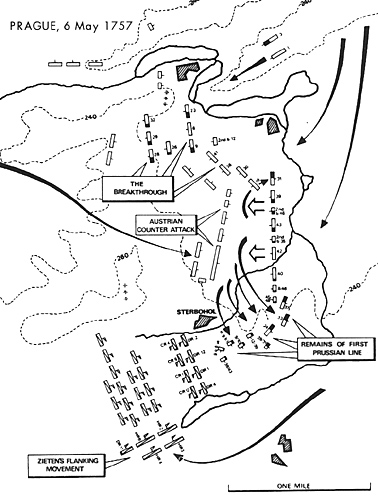
Frederick had invaded Bohemia with two columns. One (about 65,000) under his personal command advanced from Saxony while the other under Marshal Schwerin advanced from Silesia. These two columns converged on Prague where the Austrians had concentrated some 70,000 troops under Prince Charles of Lorraine.
The Austrian leader, Prince Charles, took up a position close to Prague, with his left resting on the Czskaberg heights close to the Moldau, while his right rested at Kyge, being covered by a series of marshy ponds extending from Nieder Micholup to Kyge, where the stream that joined these ponds turned to the left and ran along the front of the position, discharging itself into the Moldau at Lieben. Another Austrian army under Daun was advancing from Vienna, and was close at hand. The road by which this force was advancing on Prague ran behind the Austrian position. The Austrians formed their line of battle, as was usual at that period, in two lines, with the cavalry on the flanks.
Prince Charles' basic plan was to keep the Prussians in check until the arrival of Dann. Hearing of Schwerin's approach, he threw back his right from Kyge so as to form a "crochet" on the high ground extending from above Sterboholy toward Hortlorzes.
Frederick planned to join with Schwerin and crush Prince Charles before the arrival of Daun. Consequently, he crossed the Moldau at Podhaba and made his junction with Schwerin. Henow deployed his united army occupying a position extending from Streziskow on the right towards Sattalitz on the left. Frederick's army was thus more or less parallel to that of the Austrians.
Frederick realized that he could not attack the Austrian on their left which was supported by the Moldau and Prague. In addition, their front was also difficult to attack and therefore he decided to attack them on their right. He then wheeled his army in open columns of companies - left ahead - and circled the Austrian right passing between the ponds that extended from Micholup to Kyge.
The Prussian formed their line and moved toward the high ground above Sterboholy which was the key to the Austrian position. A first attack was repulsed but a gap appeared in the Austrian formation as they tried to prevent themselves from being turned. At the same time, Frederick also attacked the villages of Kyge and Hloupetin. In spite of the fact that Prince Charles had tried to realign his right flank, Frederick penetrated the gap (in the "Prague maneuver") and broke the Austrian army in two. The Austrians tried vainly to resist but were rolled up and forced to retire to Prague.
It is interesting to note that Prince Charles made no attempt to attack the Prussians on their line of march or to prevent the junction of their two armies. Apparently, the very strong Austrian position prevented their leaving it to attack the Prussians, who were thus to a great extent protected during their flank march. Apparently, the best way by which the Austrians could have attacked Frederick during his flank movement were closed by his attack on the villages of Kyge and Hloupetin.
Losses on both sides were heavy: 14,275 Austrians killed, wounded orcaptured; 13,200 Prussian casualties including Marshal von Schwerin who was killed leading the first infantry assault.
The Battlefield Today: The Prague battlefield is slowly being "eaten up" by the extension of the city of Prague and its suburbs. However, we were able to take some key pictures showing some of the battle's critical phases. In a few years from now, pictures of the Prague battlefield will be impossible to take.
Frederick's "Oblique Order"
-
Introduction
Prussian Tactics 1757 and the Oblique Order
Battle of Prague: May 6, 1757
Battle of Leuthen: December 5, 1757
Battle of Kolin: June 14, 1757
Conclusions, Notes, and Bibliography
Back to Empire, Eagles, & Lions Table of Contents Vol. 2 No. 4
Back to EEL List of Issues
Back to MagWeb Master Magazine List
© Copyright 1994 by Emperor's Headquarters
This article appears in MagWeb (Magazine Web) on the Internet World Wide Web.
Other articles from military history and related magazines are available at http://www.magweb.com
